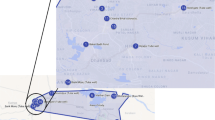Abstract
The general population’s health is directly related to the quality of the water used for drinking. As a result, research will be done on the radiation levels in the groundwater in the Charkhi Dadri area in the Indian state of Haryana. Using the LED Fluorimetry Technique, the concentration of uranium in drinking water samples taken from sources including hand pumps and tube wells of varying depths from the district will be determined. 40 water samples are gathered from various districts sites. With average value of 41.30 μg/L, variations in uranium level were noted within the range of 2–99 μg/L. The average value of uranium concentration is within the safe limit of 60 μg/L as recommended by Atomic Energy Regulatory Board, India but greater than 30 μg/L, the safe limit recommended by World Health Organization (WHO 2011). The value of cancer mortality is varying from 0.03 × 10–6 to 1.4 × 10–6 with mean value of 0.38 × 10–6 and that of cancer morbidity varying from 0.06 × 10–6 to 2.75 × 10–6 with mean value of 0.75 × 10–6. LADD value varying from 0.15 to 7.29 µg kg−1 d−1 with mean value of 1.90 µg kg−1 d−1 and HQ varying from 0.12 to 6.07 with mean value of 1.50. 60% of the samples showed HQ values greater than unity, this shows noteworthy danger of chemical poisonousness of uranium.

Similar content being viewed by others
References
Sahoo SK, Mohapatra S, Chakrabarty A, Sumesh CG, Jha VN, Tripathi RM, Puranik VD (2009) Determination of uranium at ultrarace level in packaged drinking water by Laser Fluorimeter and consequent ingestion dose. Radioprotection 45(1):55–66
Essien IO, Sandoval DN, Kuroda PK (1985) Deposition of excess amount of natural U from the at 215 mosphere. Health Phys 48:325–331
Tadmor J (1986) Atmospheric release of volatilized species of radio elements from coal-fired plants. Health Phys 50:270–273
Rani A, Singh S (2006) Analysis of uranium in drinking water samples using laser induced fluorimetry. Health Phys 91(2):101–107
Benville A and Lowder W M (1987) Human population exposures to cosmic radiation. In: Fourth International Conference on the Natural Radiation Environment, Lisbon, Portugal
ICRP (2007) The Recommendations of the International Commission on Radiological Protection. Publication 103 Ann ICRP. Permagon Press
Balaram V, Rani A, Rathore DPS (2022) Uranium in groundwater in parts of India and world: a comprehensive review of sources, impact to the environment and human health, analytical techniques, and mitigation technologies. Geosyst Geoenviron 1:100043
ICRP (1999) Protection of the public in situations of prolonged radiation exposure. The application of the commission’s system of radiological protection to controllable radi ation exposure due to natural sources and long-lived radioactive residues. ICRP Publication 82, Ann ICRP 29(1/2) Permagon Press
WHO (1998) Guidelines for Drinking Water Quality. Addendum to Volume 2
Kumar P, Sharma MC, Singh Y, Singh N, Kumar P, Chopra S (2019) Itacolumite (flexible sandstone) from Kaliana, Charkhi Dadri District, Haryana India. J Geol Soc India 93:278–284
Apha AEG, Awwa ADE, Wef lSC (1995) Standard methods for the examination of water and wastewater. Washington D. C.; American Public Health Association
Kumar A, Kaur M, Mehra R, Sharma S, Mishra R, Singh KP, Bajwa BS (2016) Quantification and assessment of health risk due to ingestion of uranium in groundwater of Jammu district, Jammu & Kashmir India. J Radianal Nucl Chem 310:793–793
Kumar M, Kumar A, Singh S, Mahajan RK, Walia TPS (2003) Uranium content measurement in drinking water samples using track etch technique. Radiat Meas 36:479–481
Rani A, Mehra R, Duggal D, Balaram V (2013) Analysis of uranium concentration in drinking water samples using ICPMS. Health Phys 104:251–255
USEPA (United States Environmental Protection Agency) (2011) National primary drinking water regulations: radionuclides. Final Rule, 40 CFR Parts 9, 141 and 142
WHO (2011) Guidelines for drinking water quality, 4th edn. Vol 1, World Health Organization, Geneva, Switzerland
United States Environmental Protection, USEPA (1990) Occurrence and exposure assessment for uranium in public drinking water supplies. Report prepared by Wade Miller Associates, Inc for the office of Drinking Water
Atomic Energy Regulatory Board AERB, DAE (2004) Drinking Water Specifications in India. Atomic Energy Regulatory Board, Mumbai, India
Chahal A, Kumar S, Panghal A, Kumar A, Singh J, Singh P, Bajwa BS (2019) Study of uranium in drinking water around the sohna fault line in Haryana. J Geol Soc India 94:428–436
Panghal A, Kumar A, Kumar SK, Singh J, Singh P, Bajwa BS, Sharma S, Mehra R (2017) Radiation dose-dependent risk on individuals due to ingestion of uranium and radon concentration in drinking water samples of four districts of Haryana India. Radiat Eff Defects 172(5–6):441–455
Rani A, Mehra R, Duggal D, Balaram V (2013) Analysis of uranium concentration in drinking water samples using ICPMS. Health Phys 104(3):251–255
Saini K, Singh P, Bajwa BS (2016) Comparative statistical analysis of carcinogenic and non-carcinogenic effects of uranium in groundwater samples from different regions of Punjab India. Appl Radiat Isot 118:196–202
Acknowledgements
We are thankful to the population of the studied area.
Author information
Authors and Affiliations
Corresponding author
Ethics declarations
Conflict of interest
The authors declare that they have no known competing financial interests or personal relationships that could have appeared to influence the work reported in this paper. The authors have no conflict of interest.
Additional information
Publisher's Note
Springer Nature remains neutral with regard to jurisdictional claims in published maps and institutional affiliations.
Rights and permissions
Springer Nature or its licensor (e.g. a society or other partner) holds exclusive rights to this article under a publishing agreement with the author(s) or other rightsholder(s); author self-archiving of the accepted manuscript version of this article is solely governed by the terms of such publishing agreement and applicable law.
About this article
Cite this article
Kumari, A., Hooda, B., Panghal, A. et al. Uranium concentration in groundwater of Charkhi Dadri district of Haryana, India by using LED fluorimeter. J Radioanal Nucl Chem (2024). https://doi.org/10.1007/s10967-024-09531-5
Received:
Accepted:
Published:
DOI: https://doi.org/10.1007/s10967-024-09531-5




